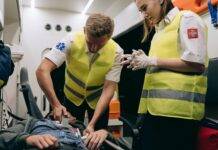
Heatstroke Prevention: Staying Cool and Safe in Hot Weather
Heatstroke Prevention : As the summer months roll in, the sun’s scorching rays can take a toll on our bodies. Heatstroke, a serious condition that occurs when the body’s temperature regulation fails, can be a life-threatening concern if not addressed promptly. In this article, we’ll explore effective strategies for preventing heatstroke and ensuring your well-being during hot weather.
1. Understanding Heatstroke: A Brief Overview
Heatstroke occurs when the body’s temperature rises to a dangerous level, overwhelming its ability to cool down. It is often a result of prolonged exposure to high temperatures and can lead to severe health complications.
2. Signs and Symptoms of Heatstroke
Recognizing the signs of heatstroke is crucial for timely intervention. Symptoms may include dizziness, nausea, rapid heartbeat, confusion, and even loss of consciousness.
3. The Importance of Hydration
Staying hydrated is fundamental in preventing heatstroke. Drink water regularly, even if you don’t feel thirsty, and avoid excessive consumption of sugary or caffeinated beverages.
4. Dressing Appropriately for the Heat
Wearing lightweight, loose-fitting clothing made of breathable fabrics can help your body regulate its temperature. Opt for light colors that reflect sunlight rather than absorbing it.
5. Staying Cool Indoors and Outdoors
Seek shade when outdoors and use umbrellas or hats for added protection. Indoors, use fans and air conditioning to maintain a comfortable environment.
6. Limiting Outdoor Activities during Peak Heat
Avoid strenuous outdoor activities during the hottest parts of the day, typically from late morning to early afternoon. If you must be outdoors, take frequent breaks in shaded areas.
7. The Role of Proper Nutrition
Consume foods with high water content, such as fruits and vegetables. These can contribute to your overall hydration and support your body’s cooling mechanisms.
8. Recognizing Vulnerable Populations
Certain groups, like the elderly, children, and individuals with pre-existing health conditions, are more susceptible to heatstroke. Keep a close eye on them and ensure their well-being.
9. Creating a Heatstroke Prevention Plan
Develop a plan that includes staying informed about the weather forecast, knowing the nearest cooling centers, and having a list of emergency contacts.
10. Emergency Measures: What to Do
If you suspect someone is experiencing heatstroke, call for medical help immediately. While waiting for assistance, move the person to a cooler place, remove excess clothing, and provide water if conscious.
11. The Science Behind Heatstroke
Understanding how the body regulates temperature and the factors that lead to heatstroke can empower you to make informed decisions in hot weather.
12. Myths and Facts about Heatstroke
Separate fact from fiction by debunking common myths surrounding heatstroke, ensuring you’re equipped with accurate information.
Anaphylaxis Management: First Aid
Cardiopulmonary Resuscitation (CPR): A Lifesaving Technique
13. Frequently Asked Questions (FAQs)
Q1: Can I still exercise outdoors in hot weather?
A1: Yes, you can exercise outdoors in hot weather, but it’s essential to take precautions. Choose cooler times of the day, such as early morning or late afternoon, and wear lightweight, breathable clothing. Stay hydrated before, during, and after exercise, and listen to your body—take breaks and seek shade if you start feeling too hot.
Q2: Is it possible to prevent heatstroke with just water?
A2: While staying hydrated with water is crucial in preventing heatstroke, it’s not the only factor. Dressing appropriately, seeking shade, avoiding strenuous activities during peak heat, and monitoring vulnerable individuals are equally important measures to prevent heat-related illnesses.
Q3: What are some early signs of dehydration?
A3: Early signs of dehydration include feeling thirsty, having a dry or sticky mouth, darker urine, reduced urine output, and feeling fatigued or dizzy. If you experience these symptoms, it’s important to start rehydrating by drinking water or electrolyte-rich beverages.
Q4: Are certain medications linked to heat sensitivity?
A4: Yes, some medications can make you more sensitive to heat and increase the risk of heat-related illnesses. These might include certain blood pressure medications, diuretics, antihistamines, and psychiatric drugs. Consult your healthcare provider to understand if your medications could impact your heat tolerance.
Q5: Can heatstroke have long-term effects on health?
A5: Yes, severe heatstroke can have long-term effects on health. It can damage vital organs, such as the brain, heart, kidneys, and muscles. Individuals who have experienced heatstroke might be more prone to heat-related illnesses in the future. It’s crucial to seek immediate medical attention if you suspect heatstroke to minimize potential long-term effects.





















